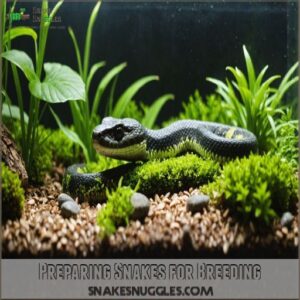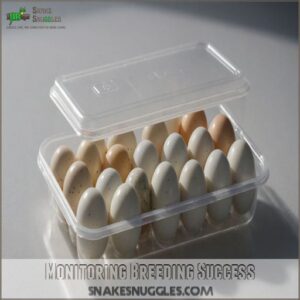This site is supported by our readers. We may earn a commission, at no cost to you, if you purchase through links.

A vital step is inducing breeding by mimicking a natural winter, a process called brumation. This involves carefully adjusting temperature and humidity. Remember, different species have different needs. Corn snakes are a popular beginner choice, known for their relatively easy care.
But even with corn snakes, proper planning is essential. Don’t rush the process; patience is key. Understanding your snakes’ specific requirements is paramount to success. We’ll explore the fascinating world of pheromones and mating rituals next – it’s way more interesting than you might think!
Table Of Contents
- Key Takeaways
- Preparing Snakes for Breeding
- Separating Sexes and Stopping Feeding
- Cooling Period and Temperature Control
- Humidity and Photoperiod Management
- Choosing Healthy Snakes for Breeding
- Selecting Snakes Free From Disease or Injury
- Ensuring Snakes Are of Mature Age and Weight
- Proper Weight for Different Snake Species
- Sexing Snakes for Compatibility
- Introducing Snakes and Mating
- Snake Reproduction and Fertilization
- Snake Pregnancy and Hatchlings
- Environmental Control for Snake Breeding
- Caring for Snake Babies
- Common Breeding Issues and Solutions
- Monitoring Breeding Success
- Post-Mating Care and Snake Health
- Frequently Asked Questions (FAQs)
- How do you breed a snake?
- How long does it take to breed a snake?
- How do you breed a snake after a hibernation?
- Do snakes breed well?
- When do snakes breed?
- How do I choose the best snakes to breed?
- How Long Does It Take for Snake Eggs to Hatch?
- What is the Best Way to Handle Snakes During the Breeding Process?
- What Type of Environment Should I Provide for the Snake Babies?
- Are There Any Special Dietary Needs for Snakes During Breeding Season?
- How Often Should I Check on the Eggs or Snake Babies?
- What is the easiest snake breed to own?
- How to prepare snakes for breeding?
- What do you need to be a snake breeder?
- Are snakes hard to breed?
- How do you choose a breeding pair?
- What are signs of snake breeding readiness?
- How do you handle aggressive snake behaviors?
- What are typical timelines for snake breeding cycles?
- How can you tell if eggs are fertile?
- Conclusion
Key Takeaways
Here are 4 key takeaways for snake breeding beginners:
- You’ll need to carefully control temperature and humidity to mimic natural breeding conditions, gradually cooling snakes before mating and maintaining proper incubation environments.
- Choose healthy, mature snakes free from disease or injury, ensuring males are at least one year old and females are around three years old before breeding.
- Provide comfortable, stress-free housing for pregnant females and closely monitor egg viability and hatchling health throughout the process.
- Be patient and prepared for species-specific needs, as breeding cycles and gestation periods can vary widely between different types of snakes.
Preparing Snakes for Breeding
To prepare your snakes for breeding, start by separating males and females into individual tanks and stop feeding them two weeks prior.
Don’t forget to gradually lower temperatures to mimic winter, ensuring they feel like they’re getting a cozy, reptilian getaway.
Separating Sexes and Stopping Feeding
Imagine this: separate your snakes like they’re teenagers in their own rooms.
Two weeks before breeding, stop feeding them.
It’s like a detox before the big day!
This helps with stress reduction and keeps them focused.
Here are some quick tips:
- Pre-breeding quarantine is essential.
- Stick to a solid feeding schedule.
- Nail that tank setup for stress-free living.
Cooling Period and Temperature Control
So, you’ve separated your snakes and stopped feeding them.
Now’s the time to embrace the brumation cycle with precision.
Gradual temperature control sets the stage for successful snake breeding.
Adjust your thermostat to reflect natural hibernation triggers: Daytime 78-83°F
Nighttime 69-73°F.
| Task | Temperature (°F) |
|---|---|
| Daytime Setting | 78-83 |
| Nighttime Setting | 69-73 |
Creating these temperature gradients mimics their natural environment beautifully!
Humidity and Photoperiod Management
Now that your snakes are comfy after their cool-down, let’s fine-tune their environment.
Humidity and photoperiod are key for breeding success!
Here’s what you need to know:
- Maintain species-specific humidity levels.
- Mimic natural photoperiod cycles.
- Use a hygrometer to monitor humidity.
- A timer controls lighting for consistent photoperiods.
Get it right, and you’ll be well on your way to happy, healthy breeding snakes!
Choosing Healthy Snakes for Breeding
Choosing snazzy snakes is important for successful breeding.
First, make sure your candidates meet age and weight requirements—these are your MVPs!
Check their breeding history like a sleuth, looking at snake genetics and feeding records.
Don’t skimp on quarantine protocols; think of it as your snake’s boot camp, prepping them for the major league of ethical breeding adventures.
Selecting Snakes Free From Disease or Injury
Before you even think about breeding, focus on picking snakes free of disease or injury.
Check for clear eyes, smooth skin, and steady breathing during health checks.
Quarantine protocols are essential when introducing new snakes.
Use parasite testing and genetic screening to make sure snake health is good.
Spot potential problems with visual cues, making sure snake breeding ethics are excellent for beginners.
Ensuring Snakes Are of Mature Age and Weight
Ensuring your snakes are of the right age and weight is key in snake breeding.
A male should be at least one year old, while females need around three years.
Check their body condition score and growth rate for breeding readiness.
Think of it as prepping athletes for a big game—it’s all about timing and form.
Happy breeding!
Proper Weight for Different Snake Species
Achieving the ideal weight for breeding involves understanding species variation.
You don’t want a snake that’s underweight or overweight.
Here’s a quick guide:
- Use weight charts to know the ideal range.
- Follow feeding guides specific to each species.
- Keep an eye on weight management for healthier, happier snakes.
Breeding’s much smoother when the basics are sound!
Sexing Snakes for Compatibility
Think of sexing techniques as a detective game in snake breeding.
You’ll often rely on visual cues or genetic testing to unravel the mystery of compatibility concerns.
For a more detailed approach, consider using a snake sexing chart to help guide your decision.
Remember, ethical breeding starts with knowing if your snakes are ready to mingle.
If in doubt, probe or
Introducing Snakes and Mating
When it’s time to introduce your snakes for mating, gently place the female into the male’s enclosure and let nature take its course—just watch out for any overly dramatic snake dances!
Keep an eye on their interactions, as some snakes might need a little environmental encouragement like a spritz of water or a change in lighting to get in the mood.
Introducing Males and Females
Someone’s gotta do it!
Introduce your male and female snakes carefully. Place the female in the male’s enclosure; monitor for aggression.
Adequate enclosure size is key for stress reduction.
Remember, proper snake sexing beforehand is essential for successful snake mating and fertilization.
Observe their courtship behaviors closely; each species has unique mating rituals.
Patience is key; successful snake breeding takes time and careful observation.
Stimulating Reproductive Behavior
To stimulate your snakes’ reproductive behavior, start by mimicking their natural environment.
Use pheromones strategically to pique interest and promote snake courtship behaviors.
Adjust lighting effects and tweak the enclosure design to create a romantic vibe—think dimmer lights for intimacy!
Stress reduction is key, so provide cozy tank mates.
With these simple snake breeding strategies, you’re set for successful snake fertilization adventures!
Aggression and Territoriality
While encouraging snakes to bond, keeping aggression in check is key. Aggression and territoriality can appear when snakes feel uneasy.
Consider observing and learning from snake dominance display signs, such as raised bodies or hissing, which can be important in understanding their behavior (Snake Dominance Items).
- Enclosure size: Make sure it’s spacious enough for both.
Unique Mating Rituals in Different Species
Imagine this: from aggressive strikes to mesmerizing snake dances, each snake species boasts its own unique mating rituals.
These include pheromone signals and fascinating mating balls.
It’s like a wild party in the snake world!
For example, some snakes like garter snakes engage in mating balls where dozens of males vie for a single female’s attention.
Here’s a quick look:
| Ritual | Species | Behavior |
|---|---|---|
| Aggressive Strikes | King Cobras | Combat display |
| Snake Dances | Corn Snakes | Rhythmic movement |
| Mating Balls | Garter Snakes | Group coiling |
| Pheromone Signals | Pythons | Scent trails |
Explore these snake breeding wonders!
Snake Reproduction and Fertilization
In the realm of snake romance, you’ll find unique behaviors like pheromone trails guiding enthusiastic suitors and hemipenes playing a key role in the act.
With amazing tricks like sperm storage for later fertilization and even parthenogenesis, where females don’t need a male’s help to have babies, there’s always something fascinating happening beneath those scaly skins!
Pheromone Trails and Mate Selection
Snakes don’t chat over dinner to pick a mate—they follow pheromone trails instead.
Imagine a snake’s version of perfume shopping, where scent intensity and scent variation signal a dreamy partner.
You’ll notice how pheromone communication helps them in mate selection.
In snake breeding, stronger chemical signals often sway the mate choice, acting like a secret love letter in the wild.
Hemipenes and Snake Reproductive Anatomy
Explore snake reproduction and you’ll find hemipenes—those nifty twin corkscrew-shaped organs—play a starring role.
They vary in size and structure, making each species unique.
During the mating process, hemipenes help deliver sperm, essential for avoiding sperm competition.
It’s a dance of anatomy and strategy, essential for successful snake breeding.
Yes, even snakes have their quirks!
Sperm Storage and Fertilization
Let’s get down to the nitty-gritty of snake reproduction!
Female snakes can hold onto sperm for a surprisingly long time—that’s sperm storage!
This leads to delayed fertilization, meaning you mightn’t see babies right away.
This also means sperm competition can occur, with the "winner" fertilizing the eggs.
Understanding sperm duration is key to successful snake breeding, impacting genetic implications and even female choice in mate selection.
It’s fascinating, right?
Parthenogenesis in Some Snake Species
Ever wonder how reproduction can occur without a male?
In some snake species, parthenogenesis lets females produce clones of themselves.
This fascinating twist impacts:
- Genetic diversity: Limited since offspring are genetic copies.
- Offspring sex: Usually female.
- Evolutionary implications: Raises questions about natural selection.
- Conservation concerns: Might affect species survival.
This unique process truly captivates science!
Snake Pregnancy and Hatchlings
When your snake is expecting, she’ll need a cozy, stress-free space to rest while you keep a close eye on her comfort.
Monitor the temperature and humidity carefully during incubation, so your hatchlings arrive healthy and ready to join the slithery world.
Gestation Periods for Different Species
In snake breeding, understanding gestation variations is essential.
Ball pythons may surprise you with a brief 44-day wait, while anacondas keep you on your toes for up to seven months.
Species comparisons highlight these gestation periods, affecting your breeding schedules.
Manage egg incubation carefully to guarantee healthy hatchlings, and know each snake species needs its own cozy timeline.
Closely Monitoring Breeding Success
After tracking those varied gestation periods, keep an eye on breeding success by monitoring egg viability, clutch size, and hatchling health.
Consistent temperature and humidity play key roles in incubation success.
Regular checks guarantee post-hatch care is effective.
It’s like watching an adventure unfold—every step revealing more about your snake breeding triumphs or troubles.
Don’t miss the magic in those moments!
Providing Comfortable Housing for Pregnant Females
Success in breeding hinges on the right environment for pregnant females. Here’s what you’ll want:
- Cozy Nest Box Design: It’s like building a comfort zone with hideaways.
- Humidity Control: Keep it steady to avoid molting mishaps.
- Feeding Frequency: Think of it as a spa menu—small, regular meals.
- Stress Reduction: Minimize disturbances for peace of mind.
Controlling Temperature and Humidity During Egg Incubation
Once your pregnant snake is comfy, it’s time to make sure her eggs are cozy, too!
Keeping an eye on temperature and humidity can make or break egg viability.
Set your incubator to the right humidity and watch for those pesky temperature fluctuations.
Think of it as a spa day for your snake eggs—calculated pampering with a precise incubation timeline for hatching success!
Environmental Control for Snake Breeding
Successfully breeding snakes hinges on carefully controlling their environment.
You’ll need to precisely manage temperature, humidity, and lighting cycles to mimic the snakes’ natural habitat and encourage successful mating and reproduction.
Setting Up a Breeding Enclosure
While nurturing hatchlings is rewarding, setting up a snake breeding enclosure requires attention to detail.
Make sure your setup is well-designed:
- Enclosure size: Spacious enough for comfortable movement.
- Substrate choice: Use a safe, easy-to-clean material.
- Hiding spots: Provide security with well-chosen places.
- Ventilation and water bowls: Maintain fresh air and hydration for a thriving environment.
Managing Temperature and Humidity
Picture a savvy reptile whisperer ensuring perfect comfort for your slithery pals. Temperature gradient is key; aim for a warm basking spot and cooler shady retreats, with ideal levels ranging from 75°F in the cool zone to 90°F in the basking area learn more about corn snake temperature.
Don’t skimp on humidity control; it’s like a spa
Providing a Natural Day-Night Rhythm
For successful snake breeding, synchronize their natural day-night rhythm. Here’s how you do it:
- Photoperiod cycles: Use timers to provide 10-14 hours of light daily, matching natural light cycles.
- Light intensity: Adjust with dimmable bulbs to mimic dawn and dusk.
- Ambient light: Position enclosures near windows for natural lighting.
These steps help maintain environmental control and keep your snakes in sync with nature!
Simulating a Cooling Period for Brumation
As you’re setting the perfect day-night cycles, think about creating a winter feel to trigger brumation.
Lower temperatures gradually to mimic colder months, using temperature gradients.
Keep your snakes cozy with ambient cooling and humidity control—just like a mini winter simulator in their habitat.
It’ll nudge them into those natural brumation cycles, making breeding a breeze!
Caring for Snake Babies
When caring for snake babies, you’ll need to provide a warm and damp environment to help them thrive.
Keep an eye on their health and success, much like watching over a classroom of curious toddlers discovering the world.
Providing a Warm and Damp Environment
Imagine creating the perfect cozy atmosphere for your baby snakes. Humidity levels are key, so consider substrate choices like coconut husk or damp moss to keep things just right. Add small water bowls for that extra moisture.
With proper ventilation and reliable heat sources, you’re setting the stage for thriving hatchlings in a delightful snake habitat.
Monitoring Hatchling Success
Once your snake eggs hatch, consistent monitoring is key to boosting hatchling survival rates.
You’ll want to keep a close eye on their growth and development, especially during the first 40 to 70 days after incubation, which is the typical snake egg hatching period.
Here’s what to watch for:
- Weight: Regular weigh-ins track feeding success.
Addressing Any Health Issues in Hatchlings
Dealing with snake hatchlings can feel like a juggling act, especially if health issues pop up.
Watch for respiratory issues, dehydration, or malnutrition.
Keep those little guys hydrated and fed, checking for parasites frequently.
Regular vet visits can catch problems early, letting your hatchlings slither into strong, healthy snakes.
Remember, a little effort now prevents big problems later.
Stay vigilant and responsive!
Common Breeding Issues and Solutions
Breeding snakes can feel like juggling, with health issues, stress, and unfertilized eggs popping up unexpectedly.
But don’t worry—addressing these challenges head-on with proper nutrition and care can turn the chaos into a rewarding experience for both you and your slithery companions.
Addressing Health Issues in Breeding Snakes
Hatchlings are thriving, so let’s focus on keeping breeders healthy.
Watch out for parasite prevention and tackle bacterial and fungal infections head-on.
A playful snake refusing to eat might signal nutritional deficiencies.
Keep stress low with proper snake breeding care.
Monitoring these health aspects helps guarantee successful snake breeding for beginners.
Remember, happy, healthy snakes mean a fruitful breeding season!
Managing Stress in Pregnant Females
Pregnant snakes, like humans, appreciate a little peace.
Make sure you’re creating a stress-free environment with a quiet enclosure and safe nesting space.
Give them some breathing room by avoiding handling.
Stick to proper nutrition for their health.
Watch them chill, knowing your snake breeding care and breeding tips are excellent!
It’s all about mastering their needs.
Dealing With Unfertilized or Dead Eggs
Wondering how to handle unfertilized or dead eggs?
Grab a flashlight and perform an egg viability assessment.
If they’re lifeless, it’s time for egg removal to prevent incubation issues like fungal infections.
Implement effective prevention strategies for future clutches.
Remember, snake breeding is an adventure, so keep your spirits high and your eyes peeled for signs of healthy snake eggs!
Ensuring Proper Nutrition for Breeding Snakes
Feeding breeders right after dealing with eggs is like adding fuel to a fire engine.
Focus on snake nutrition with the right dietary needs and prey size.
Maintain a schedule for food frequency and consider nutritional supplements to prevent vitamin deficiency.
Keep an eye on:
- Balanced diet for snake health
- Appropriate prey size
- Vitamin supplements
- Regular feeding schedule
Monitoring Breeding Success
You’ll want to keep a close eye on your snake’s eggs, regularly checking their viability and noting the number of eggs laid (clutch size).
This careful monitoring, along with tracking the health of any hatchlings, is essential for understanding your breeding success and making adjustments for future attempts – remember, even experienced breeders have setbacks!
Tracking Egg Viability and Hatchling Success
After tackling breeding issues, shift focus to egg viability and the hatchling success of your snake eggs.
Keep a close eye on the incubation environment to maintain the best conditions.
To boost hatching rates, regularly monitor temperature and humidity.
You can find a variety of snake incubators online, designed to maintain a consistent temperature and humidity for successful hatching.
Here’s a handy table for tracking:
| Aspect | Ideal Condition |
|---|---|
| Temperature | 85-90°F |
| Humidity | 80-90% |
| Hatchling Check | Daily Observations |
Monitoring Breeding Success in Different Species
You’ve checked egg viability and hatchling success, now let’s focus on understanding your snake breeding progress across different species.
Consider clutch size variation and incubation time—it can feel like juggling apples and oranges.
Keep a close eye on hatchling survival and explore parthenogenesis occurrence, which fascinates many breeders.
To master the art of snake breeding, it’s essential to understand the fundamentals of snake breeding genetics and inheritance, which determines the physical characteristics of your snakes. Track these elements to maintain genetic diversity and boost overall snake breeding success.
Identifying When The Snake Will Give Birth
So, you’re excited about the big day, huh?
To identify when your snake will give birth, track the gestation period and observe changes in snake behavior.
Look for signs like increased restlessness or nest preparation activities.
Keep a breeding calendar handy to monitor snake development.
With careful snake monitoring, you’ll be ready when it’s time for your snake’s exciting debut!
Post-Mating Care and Snake Health
Once mating is over, focus on providing your snakes with a relaxing environment and healthy meals, as it’s key for their recovery.
Think of it like a snake spa day—comfortable housing and proper nutrition help keep them in top shape and ready for future breeding adventures.
Providing Proper Housing and Nutrition
With your breeding success noted, let’s talk snake comfort. Enclosure size and cozy furnishing matter, like a snug winter sweater.
Keep water fresh—it’s a must.
Feed consistently, balancing the dietary needs your snakes crave.
When choosing a substrate, think clean and comfy.
This thoughtful snake habitat setup supports their health, making your care routine a breeze!
Prioritizing
After the excitement of snake breeding, keep female health and hatchling survival top of mind.
Focus on post-mating recovery, ensuring your snakes get proper nutrition and rest, with a balanced diet that includes frozen-thawed prey.
Redesign the enclosure for comfort and stress reduction.
Stick to appropriate breeding frequency to maintain snake health.
Remember, a comfy snake is a
Frequently Asked Questions (FAQs)
How do you breed a snake?
Isn’t it ironic that breeding snakes involves cooling them down?
Begin by separating males and females, adjust temperatures, and create specific humidity levels.
Introduce them carefully, ensuring a stress-free environment to encourage natural mating behaviors.
How long does it take to breed a snake?
Breeding snakes can take several months.
You’ll spend 60-90 days cooling them, then mating takes a few days.
Gestation varies widely, like 44 days for some or up to 7 months.
Patience is key here!
How do you breed a snake after a hibernation?
Gently reawakened from their slumber, your snakes are ready to mingle.
Introduce females to males’ enclosures, sprinkle pheromones like love perfume, and tweak lighting to spark romance.
Watch for courtship dances and make sure a cozy, stress-free habitat is provided.
Do snakes breed well?
Snakes typically breed well if you create the right environment.
Mimicking natural seasons with temperature and humidity adjustments is key.
Patience is essential, as is understanding each snake’s unique behaviors.
Success can feel as rewarding as finding buried treasure!
When do snakes breed?
When it rains, it pours, and snake breeding seasons vary by species.
Temperate snakes typically mate in spring after a cooling period.
Tropical snakes don’t need as much prep, often breeding year-round, making timing key.
How do I choose the best snakes to breed?
Choose healthy, mature snakes; males at least one year, females three.
Look for clear eyes, smooth skin, and good weight.
Quarantine new additions to prevent disease.
Breeding success hinges on healthy parents!
How Long Does It Take for Snake Eggs to Hatch?
Expect snake eggs to hatch in about 45 to 90 days, depending on the species.
Underneath that shell’s like a cozy, little nursery.
Keep temperatures steady and humidity levels just right for a successful hatch!
What is the Best Way to Handle Snakes During the Breeding Process?
Handling snakes during breeding is like playing a cautious game of chess. Keep movements slow, avoid sudden gestures, and monitor their behavior.
Provide ample hiding spots, adjust lighting, and make sure a comfortable environment is provided to encourage natural interactions.
What Type of Environment Should I Provide for the Snake Babies?
Set up a snug nursery with a warm, humid environment for your snake babies.
Keep temperatures around 75-85°F, ensuring a cozy basking spot.
Blend a damp substrate with hiding spots to create a stress-free atmosphere.
Are There Any Special Dietary Needs for Snakes During Breeding Season?
During breeding season, make sure your snakes receive a diet specifically designed for their species, focusing on maintaining healthy weight and energy levels.
Stop feeding two weeks before breeding to encourage successful mating, mimicking natural fasting patterns.
How Often Should I Check on the Eggs or Snake Babies?
Check on snake eggs or babies daily to make sure they’re thriving.
Keep an eye on humidity and temperature.
Like checking a baking cake, you don’t want surprises!
Regular monitoring helps you catch any early signs of trouble.
What is the easiest snake breed to own?
Imagine this: your day drifts by smoothly with a corn snake slithering in your care.
They’re low-maintenance, need a simple habitat, and are famously friendly.
Perfect for beginners like you venturing into snake ownership!
How to prepare snakes for breeding?
You’ll need to separate your snakes, stop feeding them, and gradually lower temperatures. Mimic winter conditions, adjusting humidity and light cycles. Remember, healthy, mature snakes are key!
What do you need to be a snake breeder?
Who knew breeding snakes would demand more than just a love for scales and slithering?
You’ll need patience, knowledge of species-specific care, proper equipment, and legal permits.
Also, having a genuine interest really helps your efforts thrive!
Are snakes hard to breed?
Breeding snakes isn’t too hard with the right know-how!
Make sure you have healthy snakes, proper environmental conditions, and patience.
Challenges include species-specific needs and potential aggression.
Start small, learn by experience, and enjoy watching nature unfold in your care.
How do you choose a breeding pair?
Did you know healthy snakes can live over 20 years?
Choose snakes free from disease with smooth skin, clear eyes, and steady breathing.
Make sure the male is at least one year old and the female three years.
What are signs of snake breeding readiness?
Your snakes are ready to breed when they’re healthy, mature, and showing interest in each other.
Look for active courting behaviors, like tail wrestling and tongue flicking.
Make sure environmental conditions mimic their natural mating season for success.
How do you handle aggressive snake behaviors?
Think of handling aggressive snakes like soothing a storm; approach calmly, minimize stress, and wear protective gloves.
Slowly introduce your presence, providing hiding spots, and ensuring the environment feels secure.
Patience and consistency are keys to success.
What are typical timelines for snake breeding cycles?
Snake breeding cycles vary widely: temperate species often need an 8-12 week cooling period, while tropical snakes might require less.
Gestation ranges from 44 days for ball pythons to seven months for anacondas.
Keep conditions ideal!
How can you tell if eggs are fertile?
Carefully examine the eggs; fertile ones are usually firm and opaque. A candling light helps you see veins inside. Infertile eggs often feel soft or translucent. Patience, friend!
Conclusion
Starting the journey of snake breeding is like opening the door to a whole new universe of fascination and patience.
By following this snake breeding guide for beginners, you’re setting the stage for success.
Remember, each snake is unique.
Key steps include controlling temperatures, managing humidity, and ensuring snakes are healthy and well-prepared.
Learn their behaviors, enjoy the process, and don’t rush.
With dedication, you’ll find hatching those little slithering miracles incredibly rewarding!


















